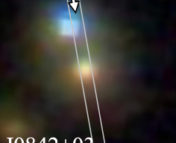Title: X-rays across the galaxy population – III. The incidence of AGN as a function of star formation rate
Authors: James Aird, Alison L. Coil, Antonis Georgakakis
First Author’s Institution: University of Leicester, Leicester, UK
Status: Published in Monthly Notices of the Royal Astronomical Society, open access on arXiv
At the centre of almost every massive galaxy lies a supermassive black hole (SMBH) into which gas and dust occasionally fall. When this happens, the central region is bathed in huge amounts of light and an active galactic nucleus (AGN) is born. They are a diverse phenomenon, emitting light in different wavelengths, with different intensities and for different lengths of time. Such variation in observed properties makes AGN very difficult to study. What factors or processes can trigger an AGN? What role does the host galaxy play? And, more specifically, how does star formation rate affect likelihood of triggering?
Previous observations of AGN have shown that galaxies with similar properties (stellar mass, star formation rate, etc.) are observed to have a wide range of luminosities. Thus, trying to understand the underlying connections between AGN activity and the properties of its host galaxy using only the observed AGN luminosity is extremely challenging. For example, two galaxies with the same mass could host AGN with hugely different observed luminosities, from which you could then conclude that the host galaxy mass played very little in role in triggering AGN. However, this approach fails to take into account that the varying AGN luminosities could be explained by the central SMBH accreting material at different rates. Today’s paper attempts to take into account these varying rates of accretion of material, and connect a galaxy’s star formation rate (SFR) to the likelihood that it will host an AGN.
A sample of AGN were identified out to high redshifts (z < 4), using near-IR selected host galaxies and cross-matching with Chandra X-ray data. The authors made sure to account for deficiencies in the X-ray satellite to attempt to correct for the fact that some AGN within the region of sky observed could have been missed. This correction gives the authors a better understanding of the underlying AGN population, not just the ones detected. For each of these galaxies, they calculate an accretion rate, λ, defined as the ratio between AGN luminosity across all wavelengths and the SMBH’s theoretical limit of accretion – approximately equal to X-ray luminosity divided by stellar mass. Using these accretion rate distributions, they calculate three quantities, described in Figure 1: the AGN fraction, the high-λ AGN fraction, and the average accretion rate.

Figure 1: Methods used to calculate the three quantities used in the paper from the accretion rate probability distributions. AGN fraction (left) is the fraction of the distribution whose emission is likely caused by an AGN and is defined as the area under the probability curve for accretion rates > 0.01; high-λ AGN fraction (middle) tracks the fraction of AGN accreting material at a large rate and is defined as the area under the curve for accretion rates > 0.1; average accretion rate (right) is defined as the area under the curve of λ x probability distribution. Adapted from Figure 1 in the paper.
If galaxies with high SFRs do make triggering an AGN more likely the authors would expect a larger fraction of those galaxies to host an AGN – the AGN fraction. To investigate this dependence, the authors split the AGN sample into star-forming (above the main sequence) and quiescent (below the main sequence) galaxies based on their relative SFRs, and also in redshift groups. Figure 2 shows how the AGN fractions and average accretion rate all increase as a function of SFR, with star-forming galaxies shown as crosses and quiescent galaxies as circles.

Figure 2: AGN fractions and average accretion rate as a function of SFR, for both star-forming (x) and quiescent (o) galaxies. Each coloured redshift bin contains multiple points, corresponding to different mass bins. The dashed line indicates a best fit relationship with SFR for star-forming galaxies at z < 2.5. Adapted from figure 5 in the paper.
As can be seen in each of these plots, the incidence of AGN in star-forming galaxies is strongly influenced by the SFR. The correlation for the star-forming galaxies is highlighted by a dashed line showing the increase out to z = 2.5. . However, quiescent galaxies have comparable, if not slightly increased AGN fractions at lower SFRs and higher redshifts. The same trends can be seen for the average accretion rates, if in more uncertain terms. SFR clearly increases the likelihood that an AGN could be triggered. Higher SFRs are correlated with an increase in the availability of cold gas that can collapse and form stars; the authors argue that this same cold gas helps with the intermittent fuelling of AGN. This is not so straightforward for the quiescent galaxies: producing similar AGN fractions at lower redshifts implies a different physical mechanism, such as stellar mass loss, is needed to explain how they fuel their AGN.
Today’s paper has demonstrated the power of investigating the distribution of AGN accretion rates, not just their luminosities, to understand the processes may trigger an AGN. Using this approach, the authors have shown that SFR plays an important role in driving AGN activity; this correlation had previously been proposed but now we see it holds for a wide range of SFRs and redshifts. These results can be used to help inform simulations about the nature, and evolution, of the relationship between a galaxy and its central SMBH.




